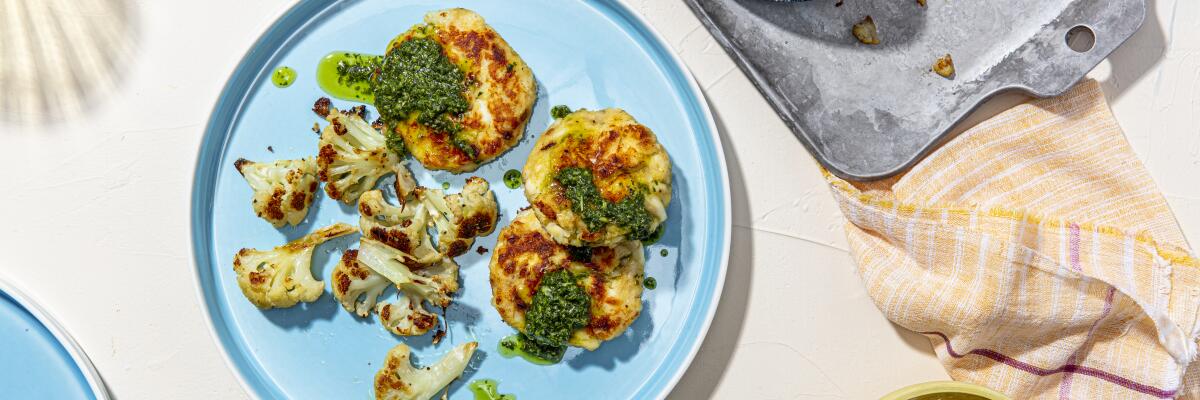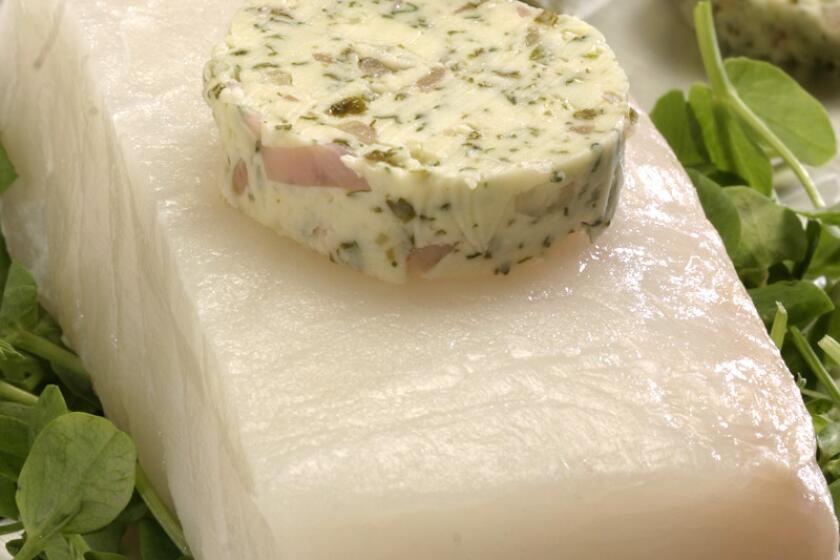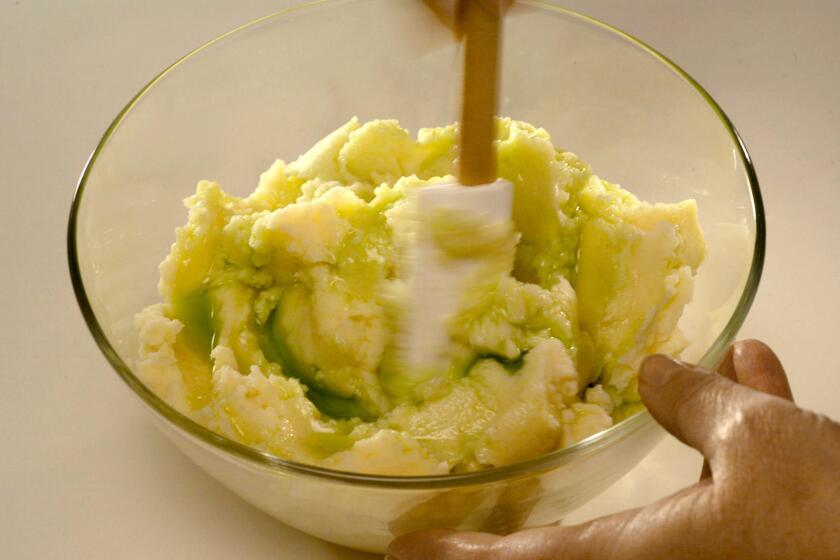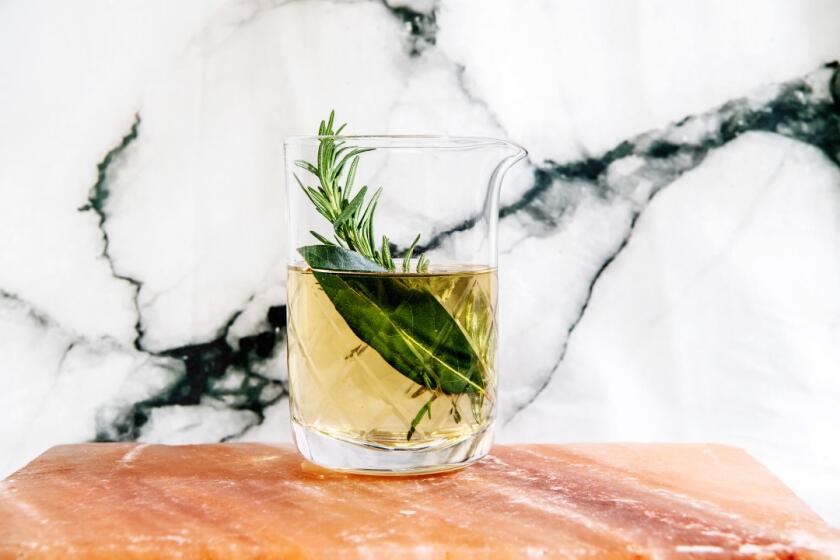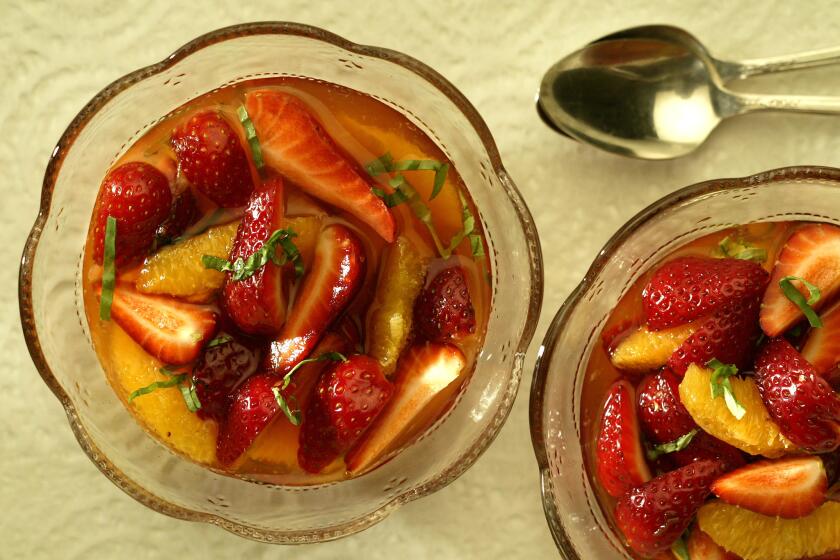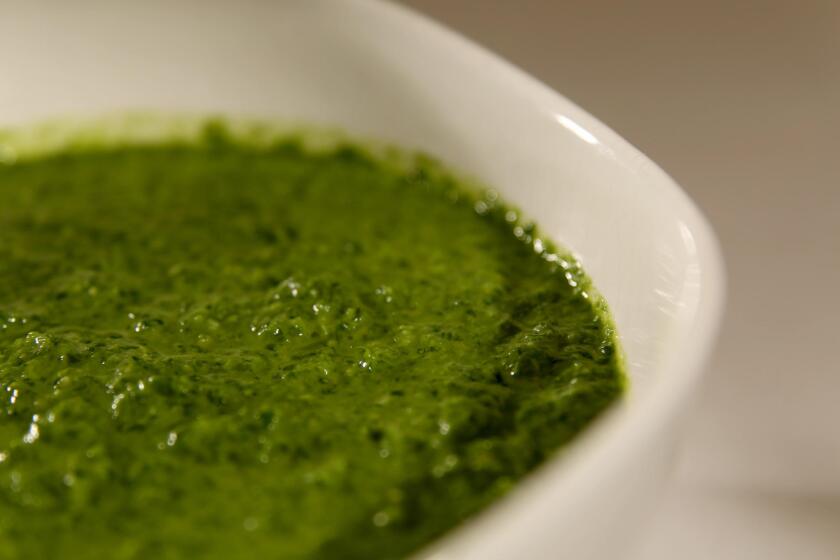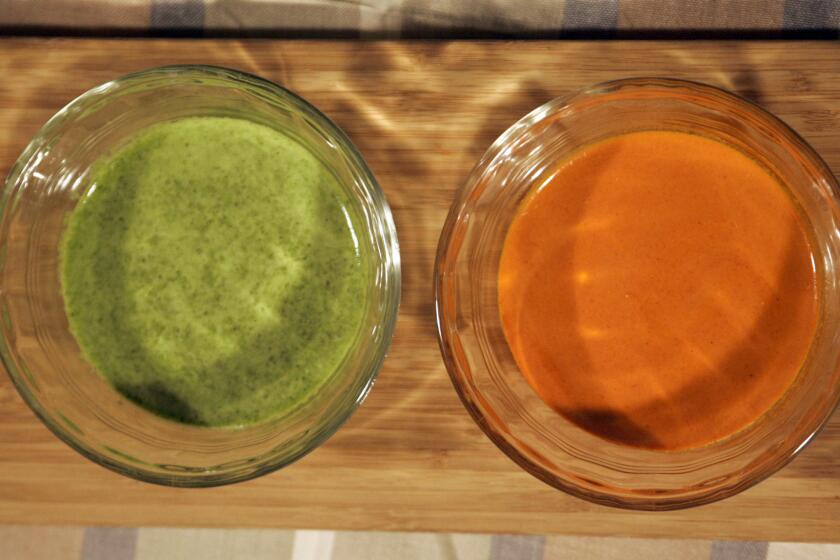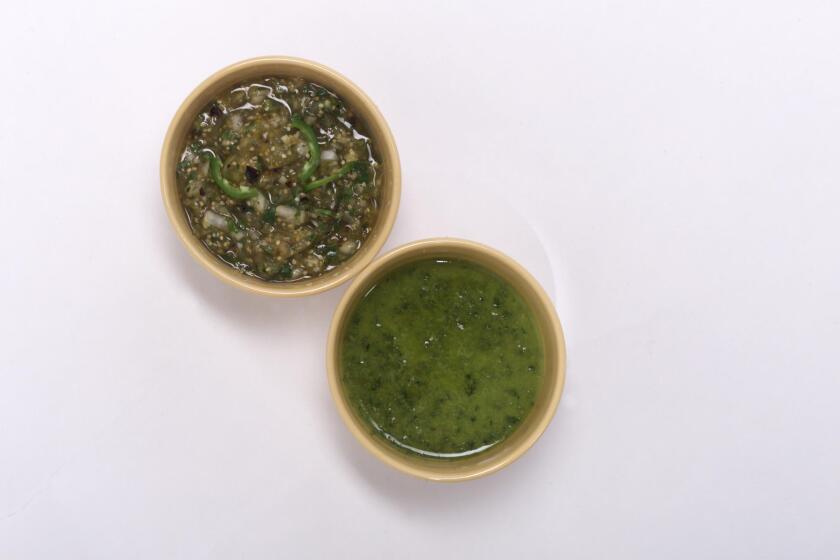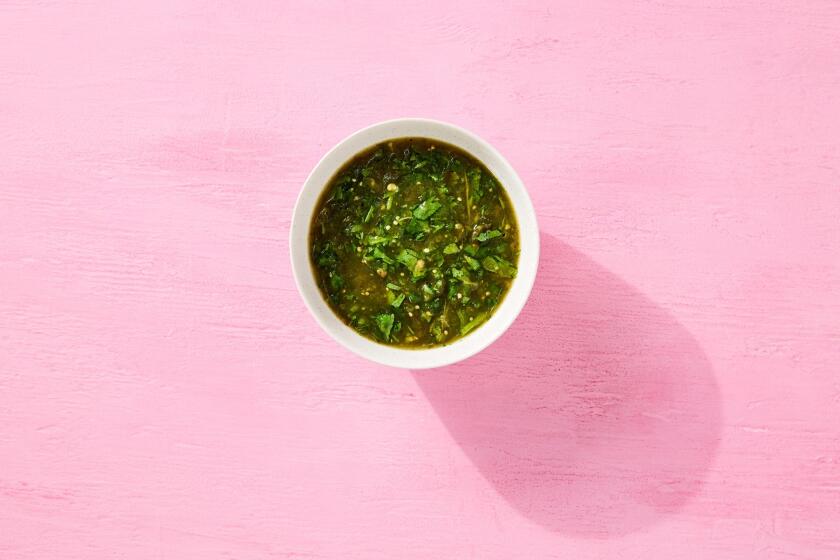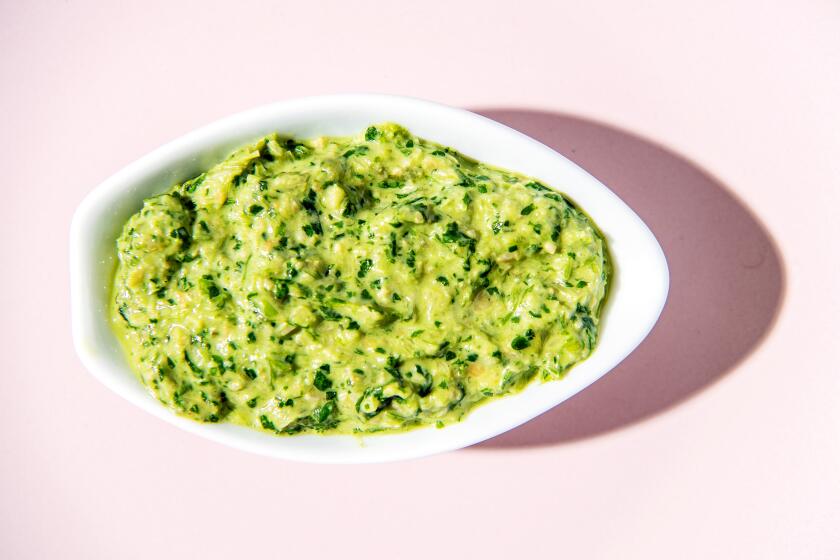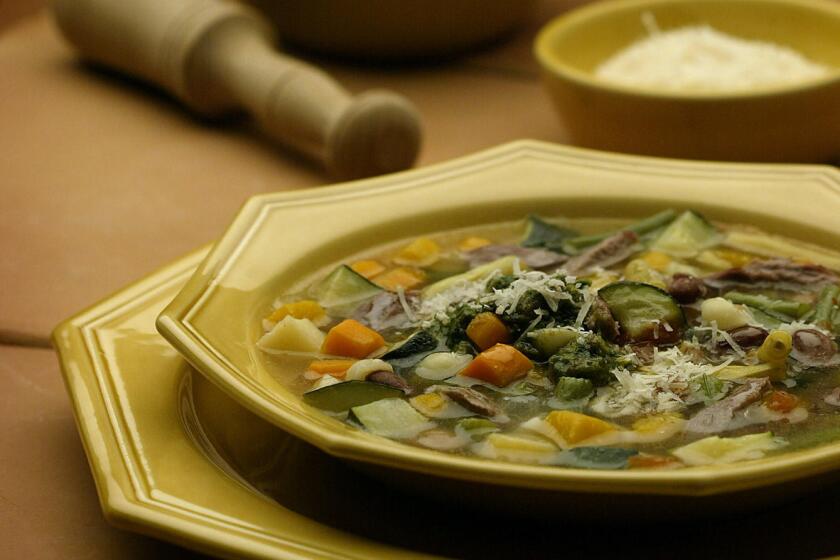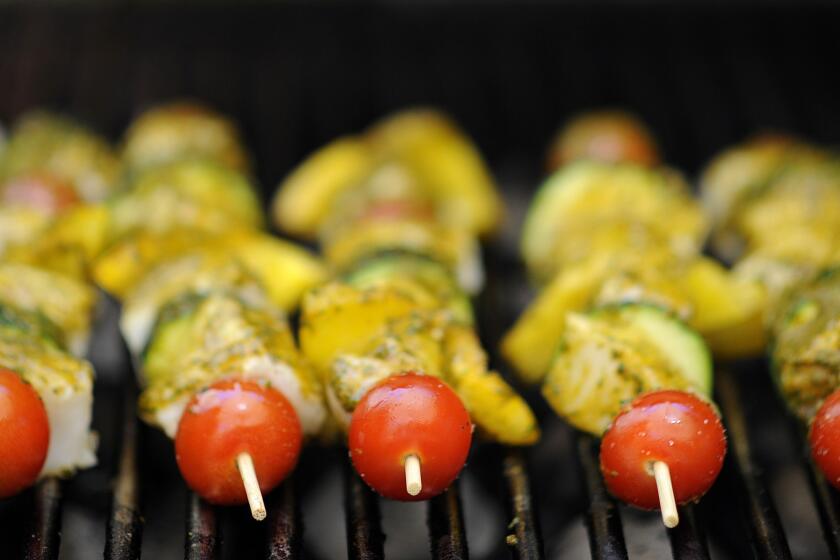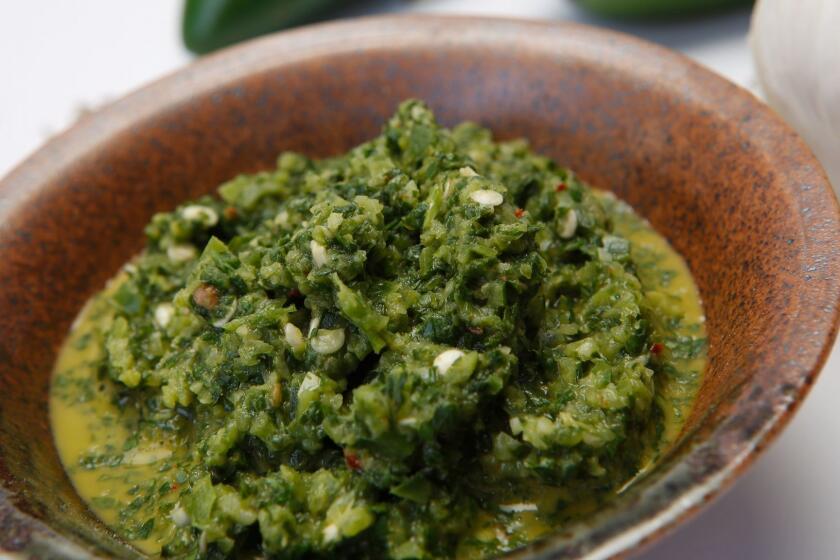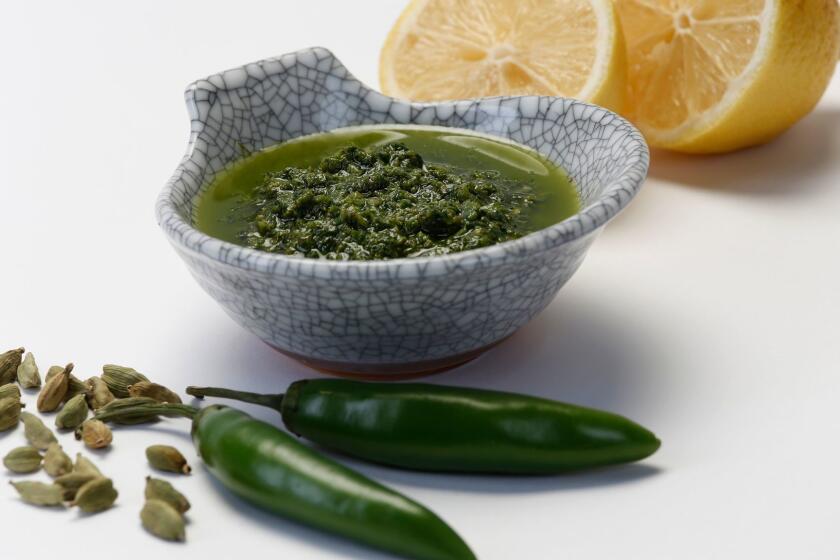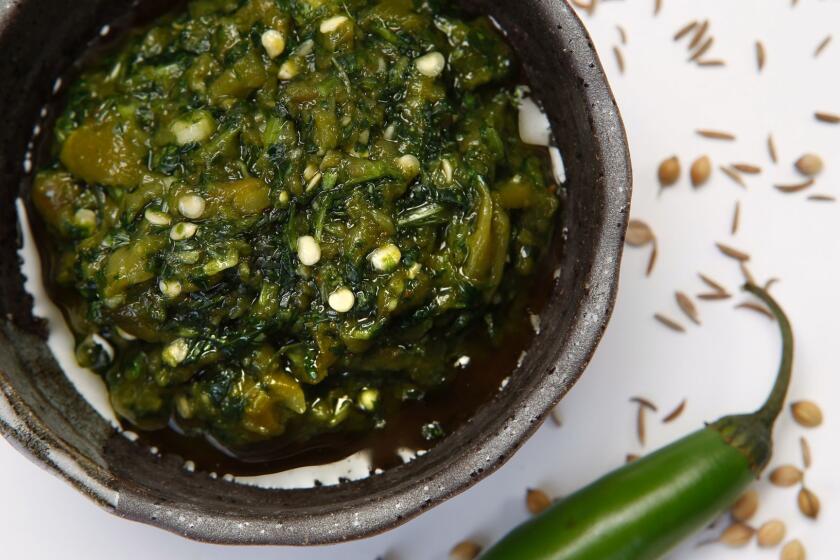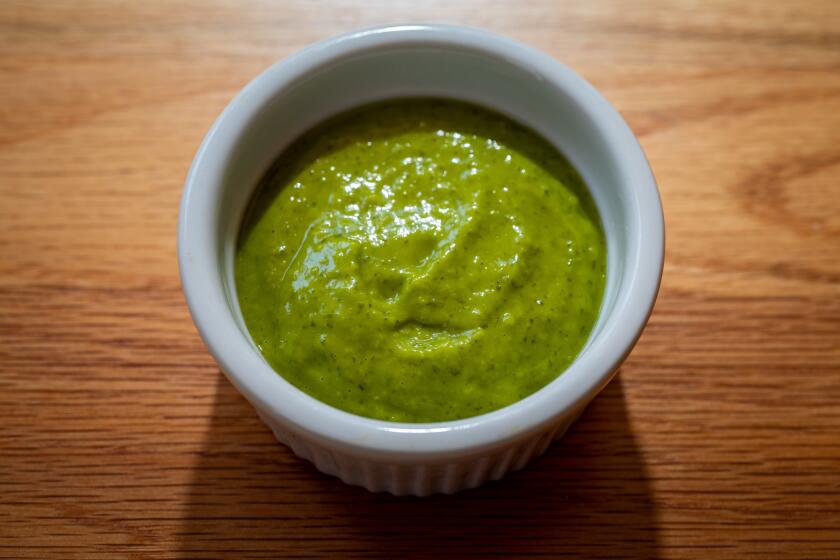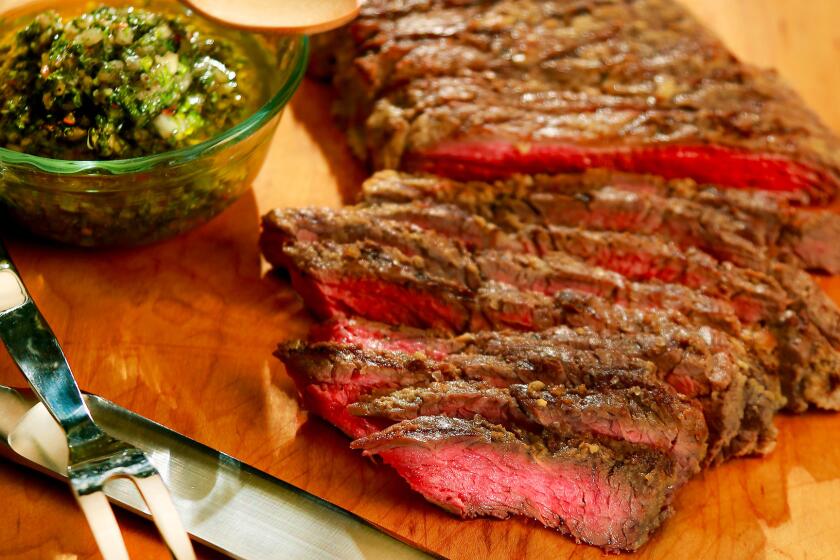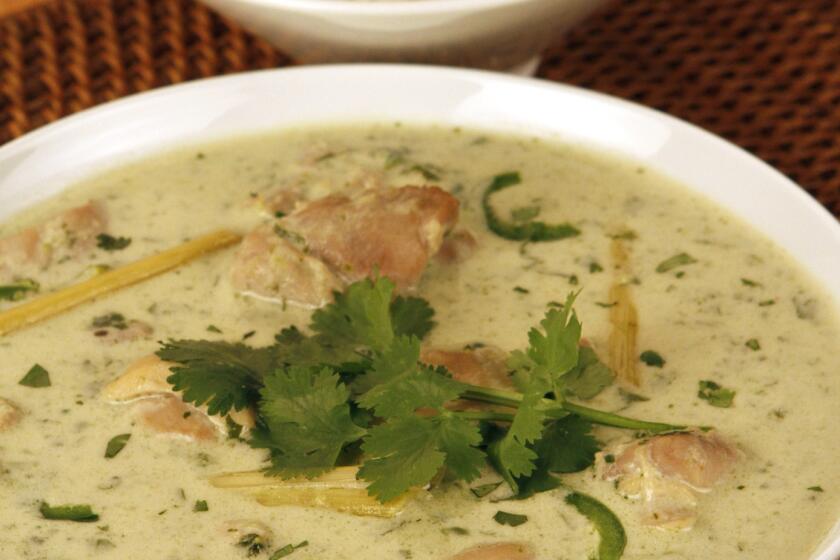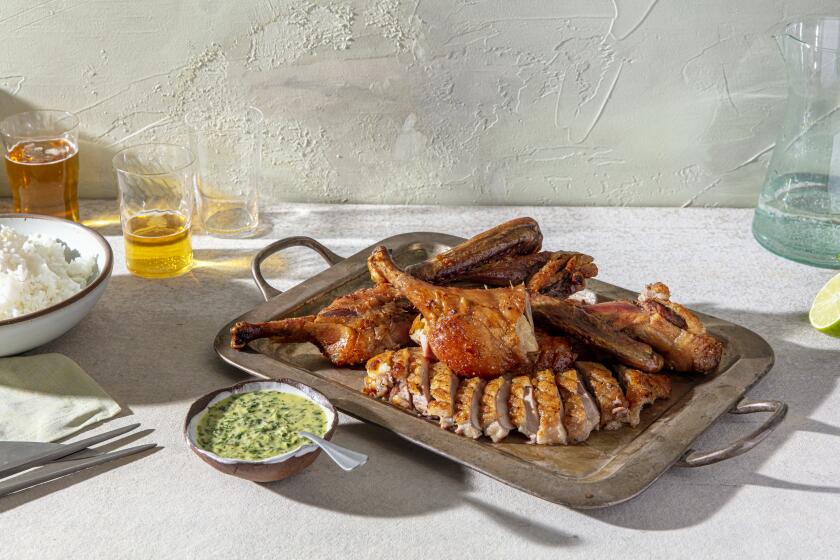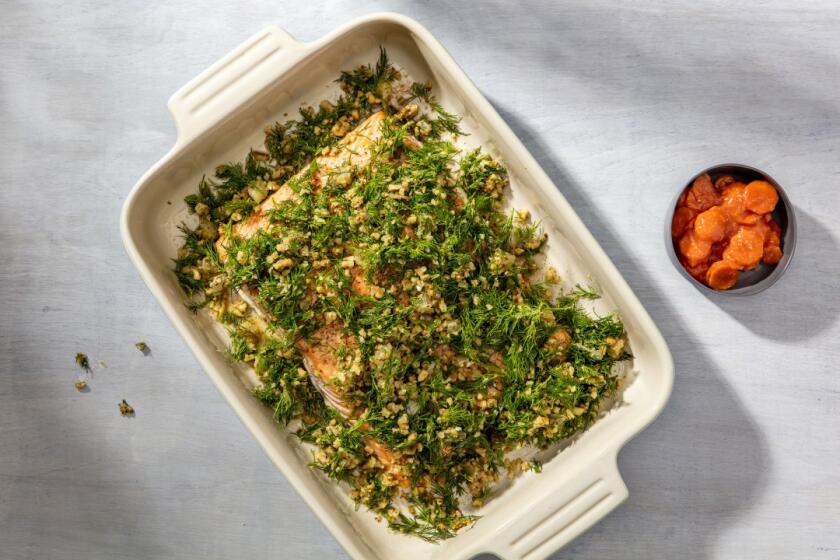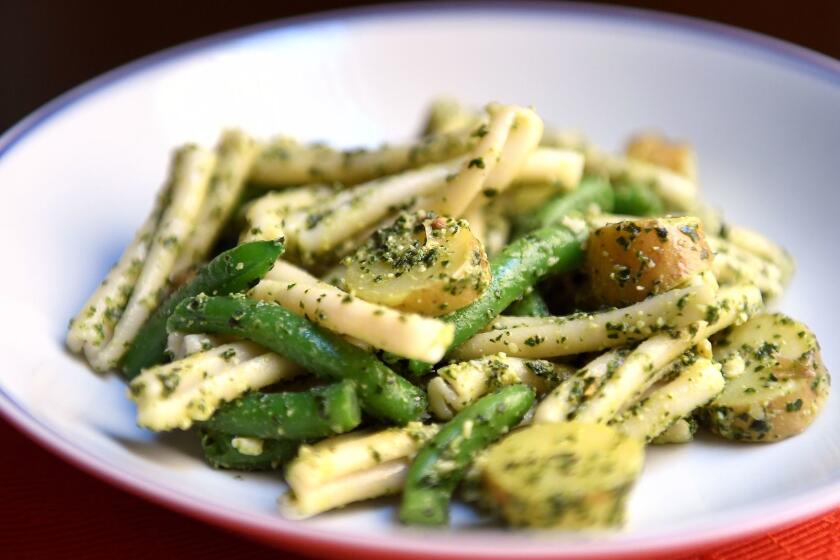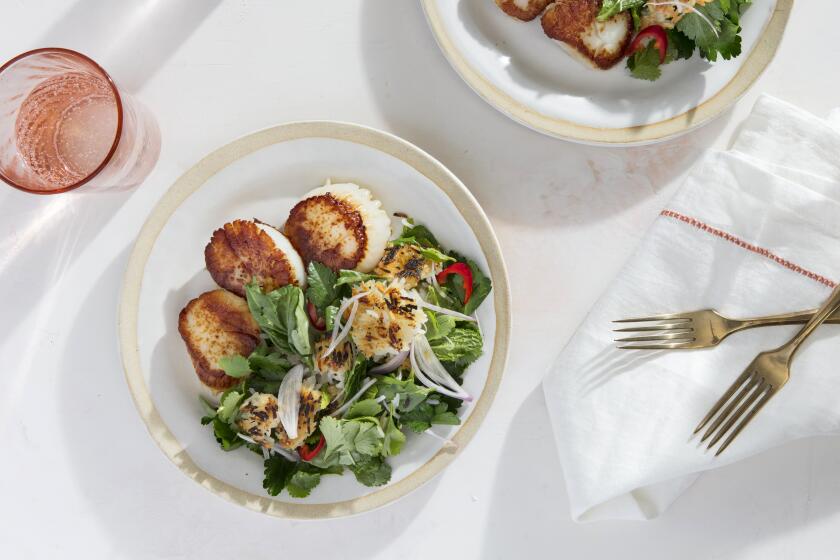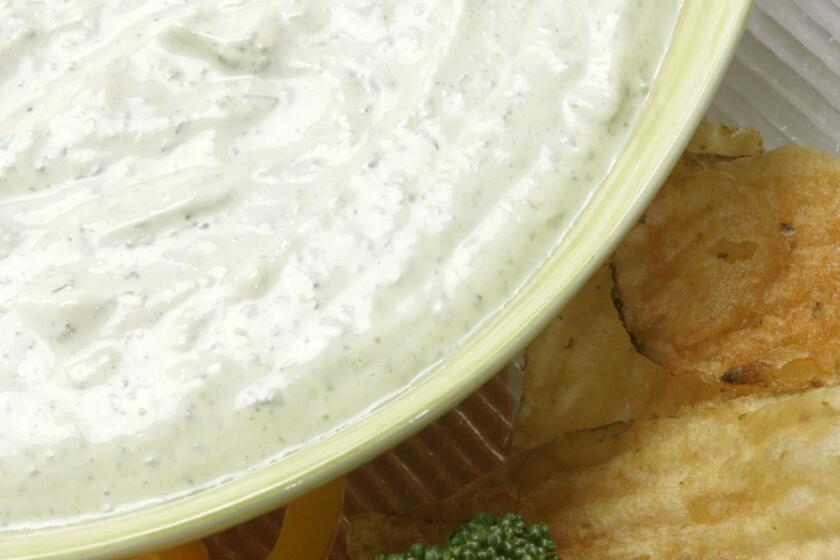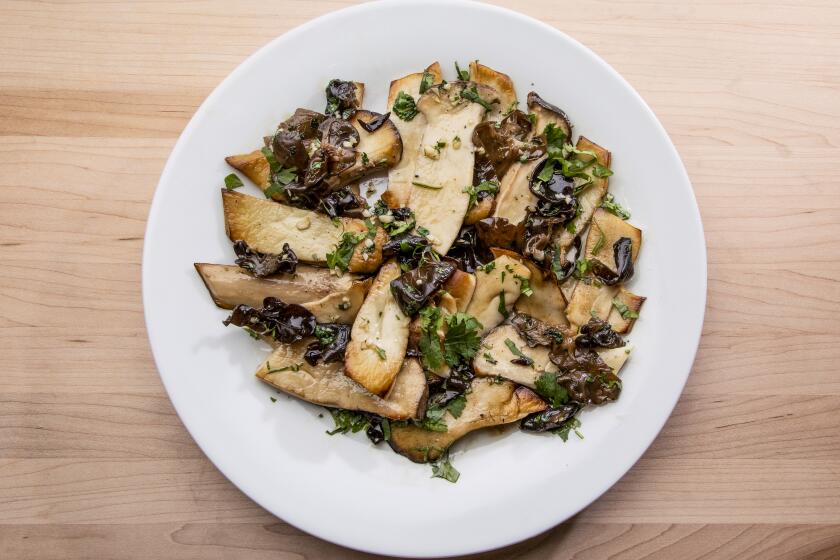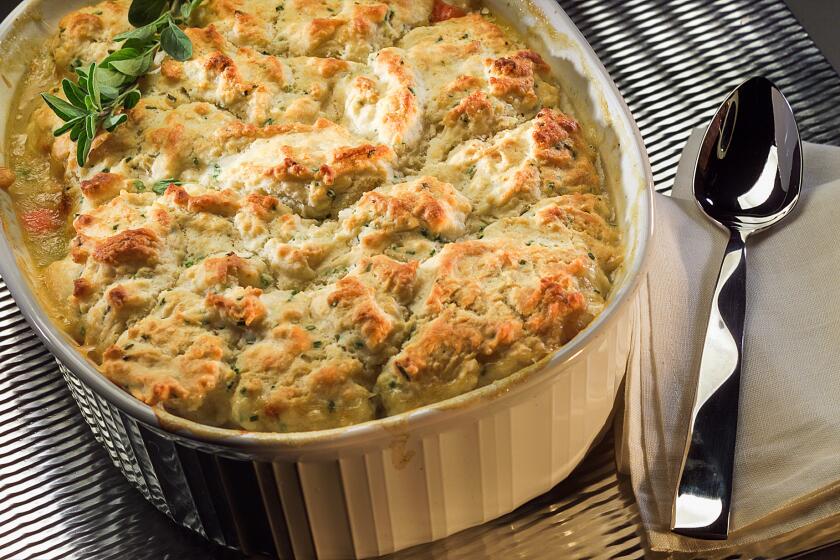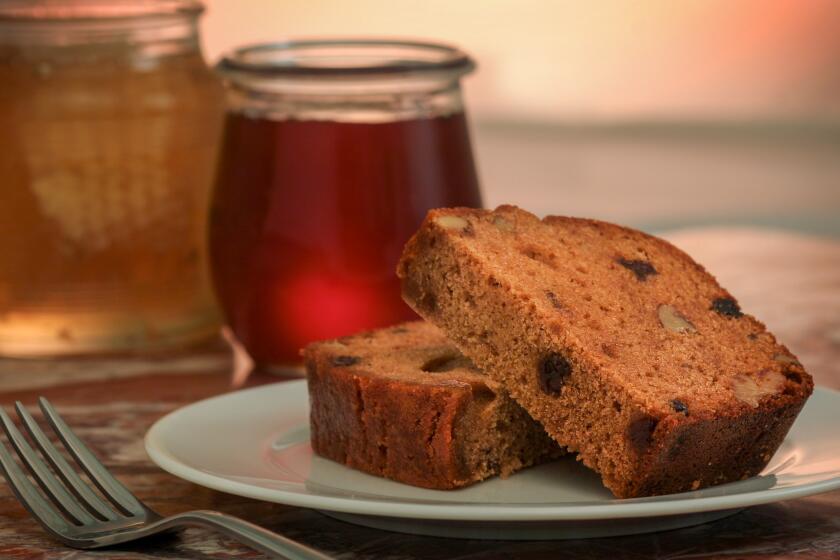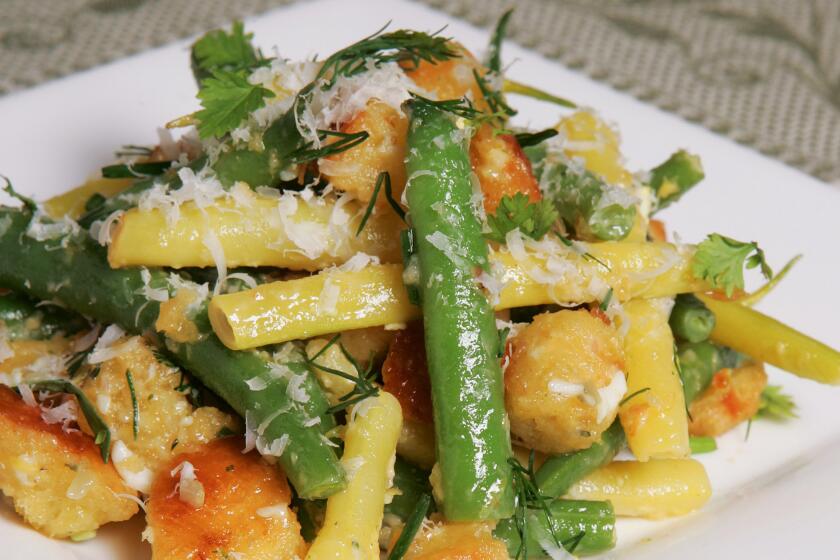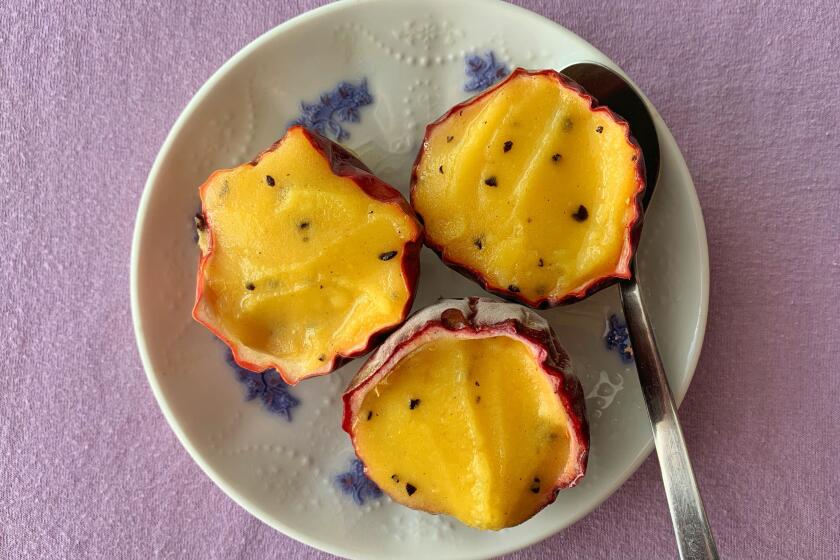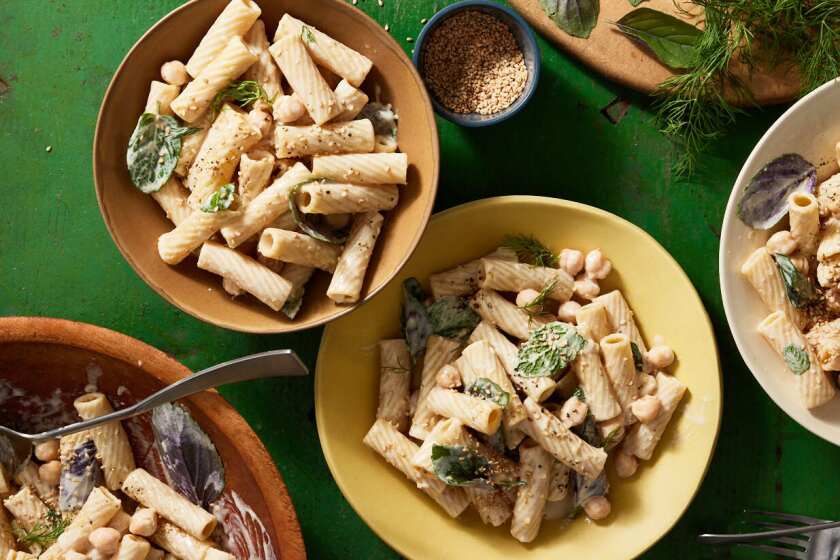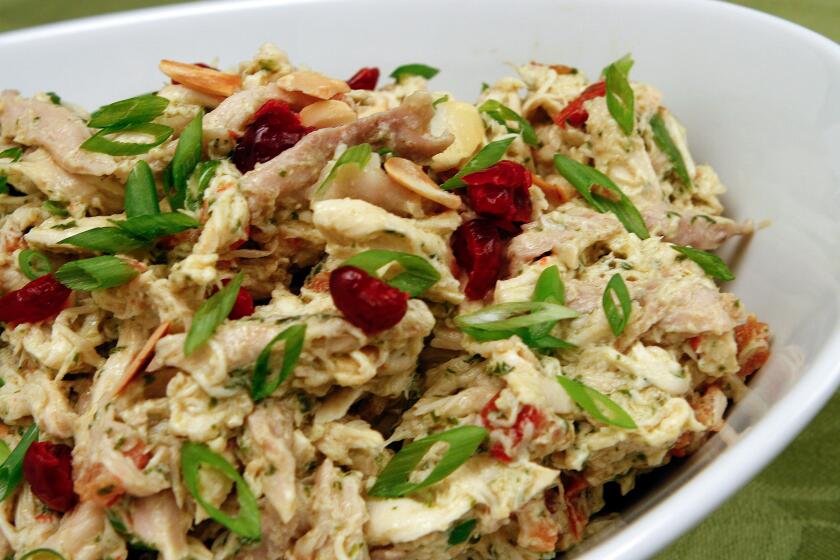Julie Giuffrida is the former Test Kitchen coordinator for the Los Angeles Times.
Recipes to infuse your food with zing
- Share via
Fresh herbs impart bright, often vivid flavors and shades of green to whatever you’re making. Incorporating them into a dish can be as simple as tossing some roughly chopped leaves into a big salad or stirring them into a soup or sauce toward the end of cooking for a pop of flavor and color. Also easy: herb butter on halibut baked “in paper” with pea sprouts.
Half a step up from the ease of snip-and-serve are infusions. Let fresh herbs steep in oil, vinegar or simple syrup that can be used in a variety of dishes. Puréed Yukon Gold potatoes are elevated to a whole new level when artfully drizzled with a vibrant green chive oil. Herb-infused oils add depth to salad dressings and brighten the flavors in sauces and stews. And lest you think herbs — and herbal infusions — are only for savory foods, try infusing simple syrup with rosemary, thyme or basil and spoon it over strawberries and oranges or sliced stone fruit for a refreshing, sweet finish to a meal.
Fresh herbs really shine when, rather than being added to a sauce, they are the sauce. “Green sauce,” pulverized fresh green herbs, garlic, oil, vinegar or citrus juice, spices and often some form of heat, is a component of many cuisines around the globe. Specifics, like which herbs and spices and how much heat, vary based on culture and climate.
In Morocco, for example, they call it chermoula; it is heavy on cilantro and cumin and is often served with fish. In Argentina, chimichurri is made with parsley and oregano; it gets its heat from red chili flakes and is a frequent accompaniment to steak and potatoes. Italian salsa verde (not to be confused with pesto) is typically made with parsley and a smattering of other herbs and anchovies, though there is no heat beyond what black pepper brings. Salsa verde Mexicana is made with tomatillos and cilantro and gets its heat from jalapeños. Then there’s mojo verde — green cilantro sauce — which also has some parsley and oregano and gets its heat from jalapeños (tomatillos not included). In Yemen, fiery zhoug is eaten with almost everything. The zhoug at three local Middle Eastern eateries, Dune, Mh Zh and the Exchange, demonstrate how recipes for “the same thing” can vary.
Pesto, the rather mild Italian “paste” of basil, pine nuts, garlic and Parmesan cheese, is often served with pasta, such as strozzapreti or trenette with pesto, green beans and potatoes. In Provence, soupe au pistou — usually a vegetable potage dolloped with pistou (pesto’s Provençal cousin) is a local favorite. California’s very own green sauce, not-at-all-spicy green goddess, is made with a variety of herbs often including tarragon and chives; it’s almost more popular as a dip than a salad dressing. Thai green curry, usually served with chicken or beef, is made with Thai basil, cilantro and lemongrass and gets its heat from Thai chiles, though serranos or jalapeños can be substituted.
One thing is for sure: Don’t get hung up on green sauce “authenticity” or names. Take a cue from dishes like spatchcocked roast duck with Vietnamese-ish herb sauce, slow-roasted salmon with dill and lemon salsa verde, crispy rice and herb salad with scallops or crispy chicken with linguine and fresh herb pesto. You can call it salsa verde, pesto, pistou, herb sauce, herb pesto or something entirely different. Whether it is a green sauce, an infusion or the leaves simply chopped and “tossed in,” fresh herbs will add a layer of flavor and color to almost any dish.
Halibut baked 'in paper' with pea sprouts and herb butter
Baking halibut in an aluminum foil packet gently steams the fish while it absorbs flavor from the pea sprouts below and the tarragon, chervil and chive flavored butter above.
Time 40 minutes
Yields Serves 6
Pureed Yukon Gold potatoes with chive oil
Having chive oil on hand is like having a bottle of liquid chives to give a quick splash of color and intense flavor to mashed potatoes, steamed fish or grilled chicken breast.
Time 1 hour 15 minutes
Yields Serves 4
Basic simple syrup with variations
Simple syrup is made of equal parts water and sugar. Flavor it with citrus, spices, liqueurs, herbs or extracts.
Rosemary-Bay Simple Syrup
This wintry simple syrup combines the pine notes of rosemary with the scent of eucalyptus in bay leaves.
Time 5 minutes
Yields Makes about 1 cup
Strawberries and Oranges in Basil Syrup
This is a simple, elegant way to serve strawberries — in a lightly flavored syrup. Basil is brilliant. Adding orange slices is not only pretty but also adds another layer of flavor.
Time 30 minutes
Yields Serves 8
Aromatic Vinegar
Vinegar awakens and refreshes foods. Infusing it with herbs such as savory, thyme, oregano, rosemary and bay adds flavor and complexity to the brightness the vinegar brings.
Time 15 minutes
Yields Makes 2 cups
Salsa verde
Fresh cilantro and spinach, garlic, lime juice and olive oil make up this salsa verde. Feel free to add anchovies and capers, tomatillos, onions and, of course, chiles.
Time 10 minutes
Yields About 1½ cups
Mojo verde (green cilantro sauce)
The fiery chile pepper from the New World goes into Canary Island mojo sauces along with cumin and fresh green cilantro, so typical of nearby Morocco.
Time 10 minutes
Yields Makes a generous half cup of sauce
Salsa verde Mexicana
In addition to being spooned over grilled fish or meat, salsa verde can be used as a sauce for enchiladas or chilaquiles. It even makes a tangy marinade for pork or chicken.
Time 10 minutes
Yields Makes 1 1/2 cups
Charred Salsa Verde
Vegan chef Jocelyn Ramirez brings more depth to her salsa verde with the addition of dried shiitake mushroom powder. Charring the tomatillos and jalapeños adds a welcome smokiness.
Time 30 minutes
Yields Makes about 4 cups.
Italian salsa verde
In Italian salsa verde, a paste of green herbs, garlic and olive oil, parsley usually predominates. Basil, sorrel, tarragon, arugula or mint often are added for subtly different flavors.
Time 20 minutes
Yields Makes about 1/2 cup
Preserved Lemon Cilantro-Scallion Paste
Preserved lemon cilantro-scallion paste is a flavorful, tangy and fresh condiment that works with any meal.
Time 25 minutes
Yields Makes about 2 cups
Soupe au pistou (vegetable soup with garlic and basil)
A Provencal staple, this soup features summer vegetables such as zucchini, green beans, squash, tomatoes and fresh borlotti beans. A dollop of emerald pistou is stirred in at the end.
Time 1 hour 45 minutes
Yields Serves 8 to 10 (makes 15 cups)
Grilled swordfish skewers with chermoula sauce
Chermoula sauce — olive oil with cilantro, garlic, paprika, cumin and a pinch of saffron — keeps these colorful swordfish kebabs moist and coats them with flavor.
Time 45 minutes
Yields Serves 4
Dune zhoug
Chef Scott Zwiezen of Dune puts his spin on zhoug by adding cumin, Aleppo pepper and extra heat (even more chiles) to the characteristic base of cilantro, chiles and garlic.
Time 15 minutes
Yields Makes about 4 cups zhoug
The Exchange zhoug
From the Exchange restaurant in Los Angeles, a heavy dose of cardamom added to the standard cilantro, chiles and garlic gives this zhoug its unique character.
Time 15 minutes
Yields Makes about 4 cups
Mh Zh's zhoug
It’s herby, it’s spicy, it’s smoky, it’s garlicky and salty enough where you can put it on anything. It uses a mix of Anaheim, jalapeño and serrano chiles.
Time 35 minutes
Yields Makes about 2 cups zhoug
Tina's Green Sauce
Avocado adds creaminess to this spicy green sauce made of jalapeños, cilantro and lime juice that's served with fried pork sandwiches at Tina's Cuban Cuisine in New York City.
Time 10 minutes
Yields Makes 1 1/2 cups
Grilled beef skirt steak with onion marinade and chimichurri
Skirt steak soaked in an onion marinade, grilled and topped with flavorful, spicy chimichurri, is a favorite at Gabrielle Quiñónez Denton and Greg Denton's Portland, Ore., restaurant, Ox.
Time 50 minutes
Yields Serves 4
Novo's Thai green chicken curry
Novo Restaurant was happy to share its recipe for this wonderfully rich and flavorful soup-like curry, which it serves with rice and chapatis.
Time 2 hours
Yields Serves 6 to 8
Crispy Chicken With Linguine and Fresh Herb Pesto
The chicken is breaded with panko, the Japanese bread crumbs that stay light and crunchy after frying. It is served with a fresh herb pesto, a variation on traditional basil pesto.
Time 25 minutes
Yields Serves 4
Fish Cakes With Salsa Verde and Roast Cauliflower
Any straggling herbs are blended with vinegar and oil into a bright herb sauce for pan-fried fish cakes and roast cauliflower.
Time 45 minutes
Yields Serves 4
Spatchcocked Roast Duck With Vietnamese-ish Herb Sauce
A Vietnamese-style herb sauce is ideal to cut the richness of a whole roast duck.
Time 2 hours, largely unattended, plus 48 hours chilling
Yields Serves 4 to 6
Slow-Roasted Salmon with Dill and Lemon Salsa Verde
A simple side of salmon gets showered with an Italian-style salsa verde, made with dill, walnuts and lemon, as soon as it comes out of the oven to add brightness to the rich fish.
Time 45 minutes
Yields Serves 4 to 6
Strozzapreti or trenette with pesto, green beans and potatoes
In this signature dish from Liguria, the pesto coats the trenette and sinks into the potatoes. Green beans contribute additional life and color.
Time 1 hour
Yields Serves 4 to 6
Crispy Rice and Herb Salad with Scallops
Crispy, buttery rice adds crunch to a bright herb salad served alongside pillowy scallops.
Time 50 minutes
Yields Serves 4
Crispy Rice and Herb Salad with Scallops
Crispy, buttery rice adds crunch to a bright herb salad served alongside pillowy scallops.
Time 50 minutes
Yields Serves 4
Green Goddess Dip
This green goddess dip is the most amazing blend of fresh herbs, herb-flavored vinegar, mayonnaise and a whole tin of anchovies.
Time 15 minutes
Yields Serves about 28

